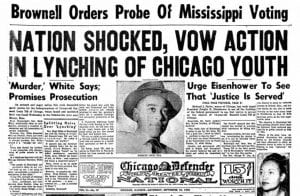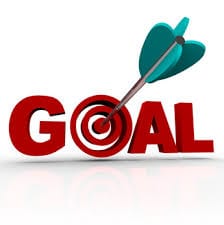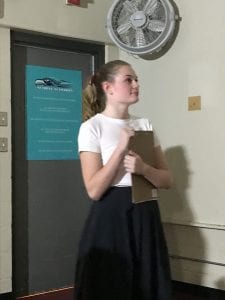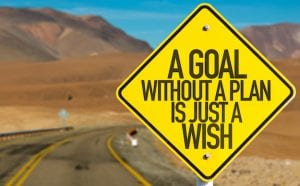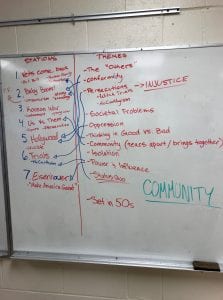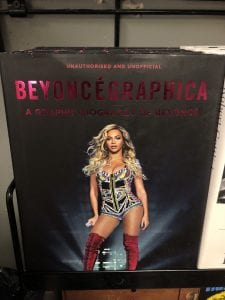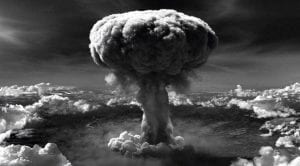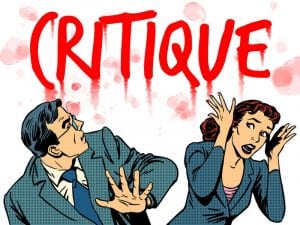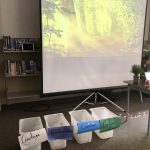Posted on March 8, 2019
We Shall Overcome
The What you just watched was a video that my partner Alex and I made as a project for PLP. We just finished a very important unit. This unit included stuff that is very hard to talk about, and that made this unit quite mentally challenging. For this unit, we learned about the civil rights movement in the United States. You’re probably confused now, because that video has nothing to do with civil rights or the United States. Well, our video does have something to do with our driving question which is, How can the actions of an individual change a system? Let me explain how we learned about the answer to our question.
In grade 11, the history we learn about is mostly the mid to late 1900’s. As you may know, our last unit was on the 1950’s. Here is the blog post on that unit. If our last unit was on the 50’s, that means that this unit had to be on the 1960’s. Specifically we focused on the civil rights movement because that was a huge part of the 60’s. Before we could learn anything we needed to figure out what we needed to learn. As a class we created a numbers document where we wrote down what we already knew about the topic, what we needed to know, and the goals we had for this unit. We continued to edit this document throughout the unit as we learned about what we needed to know.

Before we could learn about the movement, we had to learn about the history of racism and slavery in America. We learned about the civil war, reconstruction, and the Jim Crow laws. This set up the basis for the unit, and I learned about how after slavery was abolished, white people still felt the need to control African Americans, and created the Jim Crow laws to do so. The Jim Crow laws were a set of very racist laws that were put into place so white people would still have power over African Americans.
As part of the English part of this unit, we had to do Socratic Seminars. These seminars consisted of everybody in the class reading a piece of text or watching movie, then discussing the texts in groups of about 8-9. The first text we had to read was a book called Dear Martin. We divided it into two sections and discussed each section in a seminar. We also watched a couple of different movies about the movement to discuss in seminars. I really enjoyed the seminars because they helped me get a deeper understanding of the texts. Here is a little bit of one of my seminar reflections so you can have an idea of how they went.

The civil rights movement had most of its momentum in the 1960’s, but the spark that started it was ignited in the 1950’s. The laws in America stated that African Americans should be treated equally but should be separated from white people. The problem with this was that they were separated, but they weren’t treated equally. One of the ways the African Americans first started to fight for their equality was with the law. For example, Brown v. Board of Education, which was a case where an African American girl wanted to go to a white school because it was significantly closer to her and it was a better school. They ended up winning the court case because the schools were separate but not equal. Here are some other significant events of the 1950’s if you would like to read about them.
Another aspect of this unit was writing a reflection on our blog. This reflection had to compare an event we learned about in this unit to a contemporary event. When we did this post, we had only learnt about the movement in the 50’s, so I chose to compare and event to Emmett Tills murder. This post was a great way to get me thinking about how important the civil rights movement was for today. It has helped lessen racism all over North America, but it is still a huge problem that we need to solve. You can read my reflection post here.
The 1960’s was when the civil rights movement really started to pick up. Martin Luther King was the leader of the movement, and he was a great leader. He thought that the best way to fight would be to do it non-violently. This meant that instead of physically fighting and having violent riots, the movement consisted of marches and sit ins. MLK felt that the movement had to be non-violent because it needed to show that African Americans didn’t have to be feared and that they just wanted equality. Also, when the white people were violent to the people of the movement and they didn’t fight back, it made the white people look like the villains, which they were. Here are some key events of the movement in the 60’s if you would like to read about them.
After years of hard work and many lives lost, the movement finally started to get some of the rights they were fighting for. Throughout the movement segregation was ended, African Americans were able to go to school, they were able to get more jobs and paid more fairly, they gained the right to vote, they abolished the Jim Crow laws, and many, many more amazing things happened. But they didn’t get complete equality and we still live in a world full of racism. Throughout this unit we saw many different examples of how an individual can change a system. We then had the knowledge to answer the driving question in our final project for this unit.
For our project everyone in the class was partnered up, then had to make a video about a Canadian issue. This is the video that you watched at the beginning of this post. We also had to answer the driving question and come up with our own question for our video. I was partnered up with Alex, which I was very happy about because he is very intelligent, and I knew that we would work very well together. The issue we focused on for our issue was the history of discrimination Chinese Candians have had to face. Here is a pitch form with all of the detail of work we had to do for this video.
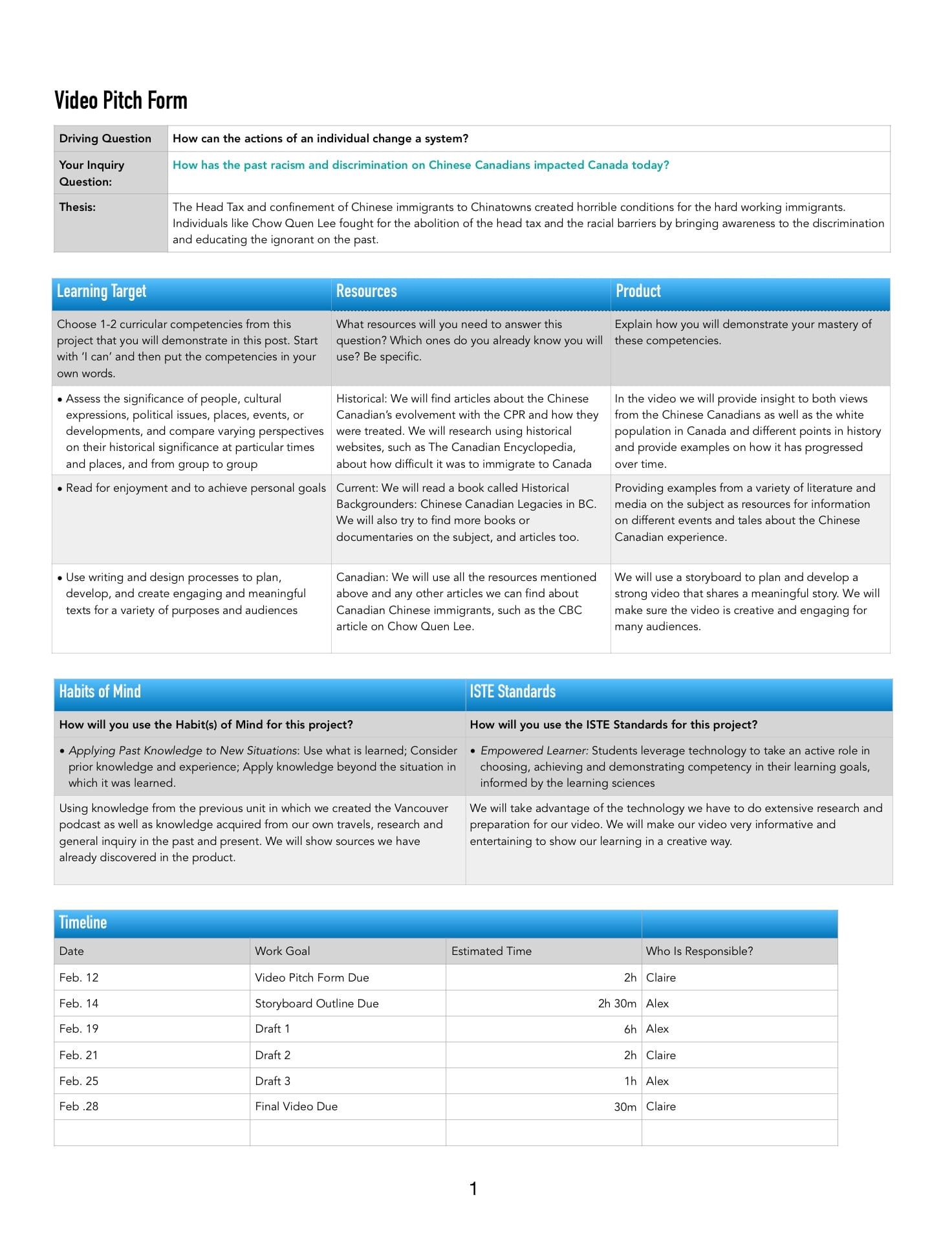
Alex and I spent a ton of time on this video. The first draft was full of information but was quite boring. We knew we had som work to do for the final draft. We wanted it to have our own creations in it so Alex made animations on Explain Everything, and I made the background music on GarageBand. The rest of our editing was done in iMovie. This video was really interesting to make. It really showed how much I learned throughout the unit, and how easy it was for me to answer the driving question by the end.
I really enjoyed working through this unit. Learning about the civil rights movement was very eye opening. I had no idea how awful the racism was in America. It was also amazing to see how much impact a single person could have on a system. MLK is a great example of this. He had such an impact that he had private meetings with the president at the time demanding that he do something to help. I feel like I have a completely different view on American history now.
Posted on January 27, 2019
Racism Is Still An Issue: Civil Rights Movement vs Today
Currently in PLP we are in the middle of a unit about the civil rights movement. The driving question for this unit is, How can the actions of an individual change a system? For this unit we have to make 2 learning portfolio posts comparing the civil rights events we learn about to contemporary events. We also had to make a product to enhance these posts.
Racism is prejudice, discrimination, or antagonism directed at someone of a different race based on the belief that one’s own race is superior. Racism has been around for a very, very long time and as much as we would like to think it doesn’t exist anymore, it is still a very big problem. Racism is something that people like to believe doesn’t exist. For example, back in the 1950’s people in the north of American tried to pretend that racism in the south didn’t exist. Today, people all over Canada try to pretend like racism has been fixed but it is still a huge problem and I’d like to share an example of it. I have put together a book comparing an event in history to a contemporary event. I have compared the murder of Emmett Till to the way police in Thunder Bay, Ontario treat indigenous people. Here it is.
After putting this book together I have a deeper understanding about how an individual can change a system. Emmett Till wasn’t the only African American who was brutally murdered but his mom decided to stand up to the system and show everyone just how bad racism in the south can be. Indigenous people in Canada have been discriminated against since the first European came to Canada. The people of Thunder Bay are standing up to the systemic racism in the police force by challenging their work and sharing their disappointment with way their cases were being handled. These are both examples of how spreading information can help change a system.

After doing lots of research about these topics it is clear that racism is still a huge issue. When a whole system is racist it can ruin the trust between people. Emmett Till’s family couldn’t trust that the law would be able to deliver justice because they were racist. The indigenous people of Thunder Bay can’t trust the police to treat them equally. People in positions of power have to treat everyone equally or they shouldn’t be in a position of power. Hopefully, we can one day have no more racism in our world.

Posted on January 21, 2019
Mpol 2019
I can not believe that I am already half way through grade 11. The first half of this school year has gone by so quickly. It’s had it’s ups and downs but overall I am quite happy with how this year has gone so far. This is my 7th presentation at learning so I am actually excited for it. I’ve started to really enjoy sharing my learning and thinking about how I can improve. If you want to learn more about presentations of learning you can read on of my past posts here.
This year I have challenged myself and set many goals, and I’ve been working very hard to reach my goals. Coming into PLP this year I knew I wanted to produce top quality work. PGP has really helped me set goals for this year and know what I need to work on. One habit of mind that I really want to focus on for this year is remaining open to continuous learning. I want to be able to know when I don’t understand something, and be able to find a way to learn more about it. A ISTE standard that I really want to improve on is being a creative communicator. I want to communicate my learning in very creative ways and express myself more through my work.
Getting started this year after the summer was a little challenging and I didn’t get off to the best start. The first project we did was a History in Five video about the making of the atomic bomb in Hanford. This was a group project that was part of a field school. Here is my post on it.
My groups video wasn’t bad. It had strong information, and great shots on location, but it was very boring. It was not very creative at all. Also I did not do really challenge myself much with this project or take on much of a leadership role. My group did work very well together and we made some strong revisions but it could have turned out better. I also didn’t learn as much as I could have. I thought I knew enough and didn’t do any extra research to help me learn more. As much as I wasn’t happy with the outcome of this video I am happy about this project. It helped me see what I can improve on for my projects in the rest of the year.
The next big project we did in PLP went way better. Coming into this project I knew my goals and what I wanted to improve on. I also was really excited to work on this project so it made it easier to want to challenge myself. This project was to create an interactive experience about the 1950’s with themes from the crucible. You can read my post on it here.
My first goal I wanted to work on in this project was to be more of a leader. This was a class project so it was up to the class to vote for 2 leaders. Sadly the class didn’t vote for me. The people they chose for leaders had been leaders in projects many times before so everyone knew they would be good. To help everyone see that I can be a good leader I am going to start being a leader in very small projects and build my way hope. Hopefully next time a project like this comes along I will be able to be one of the main leaders. Even though I wasn’t chosen for a main leader I still wanted to use my leadership in some way so I became the DRI of costumes and makeup.
Another way I challenged myself with this project was taking on a big role in the performance. I have very bad anxiety and talking in front of people scares me a lot. I have gotten a lot better at it since I started PLP, but I can still improve. I decided that I wanted to be a guide which was the biggest role in our experience. I worked very hard to memorize my script and do a good job. I was nervous at first but I ended up having a very good time. It was a huge challenge for me to be so over the top in this role but I’m so happy I did it. I want to continue challenging myself in this way for future projects.
YPart of this unit was reading the crucible. One way that we used to show our understanding of the play was to make 3 Creative Creation blog posts on it. I thought this was a great way to step out of my box and be really creative. Here are my three Creative Creation posts.
Instead of just writing a paragraph or drawing a picture I wanted to be more unique. For my posts I made a collage, made a book, and used new tools/short codes in my blog. I was very happy with how all of these turned out. I felt like I learned a lot in this project and showed it through my work. When I didn’t understand something or wanted to learn more I did the extra research I needed.
Throughout all of this year we have also been working on Personal Growth Plans (PGP). This has included learning about certain habits of mind and ISTE standards that we will be working on this year. Another big part of it is setting goals and finding ways to reach them. We had to read a book called, What Do You Really Want? How To Set A Goal And Go For It! A Guide For Teens, and we had to fill out forms and do activities while we read it. I feel like I’ve set some pretty strong goals for myself this year and I am already working hard on reaching them. I can’t wait to see where I get to by the end of the year.
The last part of the mpol is to come up with a question for my teachers and parents about how I can improve as a learner. How can I challenge myself to communicate my learning in different, more innovated ways?
Posted on January 11, 2019
Carousel of Communism
December isn’t the most wonderful time of the year only because of Christmas. It is also the time for the PLP Winter Exhibition! I have written countless posts on exhibitions now that this is my fourth year in PLP, but in case you don’t know what an PLP Exhibition is I’ll explain it to you. The Winter Exhibition is a chance for PLP students to showcase projects that they worked on before the break. Each grade has a different project and presents them in different ways. Here is one of my past posts on the Winter Exhibition.This years Exhibition was a little different than ones we’ve had in the past. For the grade 11’s (my grade) instead of each person doing an individual project, we all worked on one project together, and it was so much fun. Let me tell you more about it.
For the exhibition this year we didn’t have free range on the project, which I actually preferred. The project was based on part of the curriculum for this year, the 1950’s. We started off this unit by learning about life in the 1950’s. We watched an episode of an old TV show called Leave It To Beaver, which is a show about the ideal family of the 1950’s. The ideal family consisted of a stay at home mom, working dad, and two to three kids. Here is a little taste of the show.
Our main theme for this unit was Injustice. Injustice was a big part of the 1950’s as there were many injustices happening in America, such as sexism. To help us develope a better understanding of injustices we read a play called The Crucible. It is a play written by Arthur Miller about the Salem witch trials. The play was a little challenging to read because it had language from 1600’s, but I very much enjoyed reading it.
As we were reading the crucible we had to make three different creative creations for our blog. We were given 10 choices of themes from the crucible to write about such as revenge and remorse. We could choose any way we wanted to represent these themes. Here are some examples.
I really enjoyed writing these posts because they required me to think deeper about the themes and develope a greater understanding of them. Here are my three posts.
After we had finished reading The Crucible we started to learn more about the 1950’s. We watched a couple of documentaries and we discussed everything we learned. Although the 1950’s were called the best years of America, they weren’t all fun times. It was also the time of the Red scare. The Red scare was the fear in America that communist spies were living all around them. Many people were accused of being communists and brought to trial by Senator McCarthy. It was interesting learning about the 1950’s after the crucible because they connected in so many ways. For example, the injustice in the Salem witch trials was very similar to the injustice in the McCarthy trials.
Once we had learned everything we needed to about the 1950’s and injustice, we started working on our project for the exhibition. The project was to create an immersive experience set in the 1950’s with the themes from the crucible. Pretty much we had to create an interactive, walk through play. A couple of years ago another grade 11 glass did a very similar thing. Here is one of their posts on it. I was very excited about this project. I loved the idea of working with the whole class. Almost all of us have been together since grade 8, so we know each other very well.
One of my goals for this year was to be more of a leader in projects so when I heard about this project I thought it was the perfect chance to use my leadership skills. Sadly, a couple of other people wanted to be leaders and because they had been leaders before, the class voted for them instead. Our Directly Responsible Individuals (DRI’s) were Adam and Mimi. Our first step of this project was to plan everything out. Our teachers were away on a field school with another class while we did this so we didn’t have any help. I feel like we worked better without our teachers because we all knew we had to step up to make this amazing. We divided up the work between us and worked very well together. Here is our first draft of stations and the themes from the crucible.
Once we had all of our stations planned we had to start getting everything ready for the exhibition. We had sets to design, props to build, a script to write, and costumes to get. The script was the first thing to be done and once that was done everyone was assigned a role. There were roles in each of the 6 scenes and 4 guides to take everyone through. I got to be a guide which I was happy about because it was the biggest part and it pushed me out of my comfort zone a lot. I was also the DRI for costumes so I was in charge of deciding what everyone would wear and making sure we had everything we needed. Building everything was probably my favourite part of making this project because everyone worked very hard and were very eager to help. After everything was done it was finally time for the exhibition.
As always, the exhibition day was very stressful. We built last minute props, made sure we had everything we needed, and made sure we knew all of our lines. We got to do this in the gym so we had to set everything up after school which only gave us 3 hours. We had curtains to divide the scenes and a big wall down the centre of the gym. When we went to open up the wall we discovered that it was broken. After 10 minutes of panic we figured out a solution and made use of the dividers we had. Here is a video of the beginning of the set up.
We set everything up and it looked really good. The gym looked so different when we were done setting up. Everyone got in their costumes and we were ready to go. I couldn’t wait to get started.
I was the second guide to do a tour and it went pretty well. We took in groups of 15-25 people every 15 mins. I was very nervous at first but I quickly warmed up to it. The experience was shorter than we wanted it to be so the guides doubled up and did the tours together. This allowed more improvisation to make the experience longer. I partnered up with Adam and we worked very well together. My improv skills improved a lot and so did my people skills. This project made me a lot more comfortable presenting in front of people. Here is a video of the experience. Sorry about the camera blocking it a bit.
This was by far my favourite project I have ever done. I loved doing a class project. I got to work with everyone and it was so much fun. Even though I wasn’t a leader of the project I didn’t let it get me down and I still took on as much of a leadership role as I could. The end product turned out way better than I could have ever imagined. It was so much fun to be a guide and everyone seemed to really enjoy it. The class worked so well together and I was so proud of everyone. I really hope we get to do another project like this again soon.
Posted on November 23, 2018
How to Spot a Gym Rat
This is part 3/3 of my Crucible creations blog posts. You can also read my First and Second post of Crucible creations. We have just finished reading a play called The Crucible. This play deals with a lot of themes including revenge, injustice, witchery, and more. For this assignment we have to focus in on one of the theme and make a creation for it. We then had to put it in a blog post. For my final post in this assignment I read an essay called, How to Spot a Witch, so I had to make a creation that shows how to spot something. I chose to show you how to spot a gym rat.
In case you don’t know, a gym rat is a person who spends all of their leisure time in a gym or playing sports. They love working out and do it as much as possible. Some gym rats are harder to spot than others but the average gym rat is quite noticeable. Here is how to spot a gym rat.
What They Wear:
Most gym rats always dress like they are going to the gym. This way they can always be ready for a workout. They wear athletic clothing everywhere they can including work, shopping, and out for dinner. Click the bars to read more.
What They Say:
To be honest, most gym rats will probably tell you that they go to the gym a lot to make sure you know that they work out, but if they don’t here are a few things they might say to let you know they are a gym rat. If you go out for dinner, they will probably mention something about the diet they are on to help them get more muscle. If you go for a walk, they will probably complain about how sore they are from their workout. If you try and make plans with them, they will probably say they can’t because they have plans to go to the gym. Even if they don’t specifically tell you that they go to the gym a lot, a gym rat will always find a way to let you know.
What They Do:
A gym rat often does a lot of little things that help you to spot them. One thing they do is try to make plans to do things that will show off their muscles. Examples of these things include, going to the beach, doing something athletic (rock climbing, kayaking, etc.), or going shopping for athletic wear. Another things they do is try to show off their strength. They can do this by offering to open something for you, and offering to help carry heavy stuff.
I hope this helps you to spot a gym rat!
Posted on November 16, 2018
Revenge!
This is part 2 of 3 of my Crucible Creations. We are reading the play, The Crucible, and it has a lot of different topics in it. For this assignment everyone had to focus on three of the topics and create something for it. We had a lot of freedom with this assignment which was very nice and made it fun. We also had to write a blog post for each of them. If you would like to read part 1 click Here.
For part 2 of my Crucible Creations I chose to focus on revenge. In the play, Abigail takes revenge on John Proctor for his dismissal of her. The job was revenge was to describe a time someone sought revenge on me or I sought revenge on someone. I decided to share a story of a time I sought revenge on my sister.
My sister and I fight a lot, as most siblings do, so it was very easy to remember a time I sought revenge on her. Revenge isn’t something I commonly seek because I feel that it is pointless, and it is better to just talk things out, but my sister really deserved this. I hope you enjoy reading about my revenge!
Posted on November 10, 2018
My Version of Heaven
In PLP we are reading a play called, The Crucible. This play deals with a lot of serious topics so we were given an assignment to dig a little deeper and reflect on three of the topics in three different posts. The topic I chose to focus on for this post was what my concept of heaven is. To be honest I have thought about what I think heaven is a lot. Most people probably think heaven is a place where you have everything that you have ever wanted but I disagree. Just because you have everything you have ever wanted it doesn’t mean that you will be happy.
In my concept of heaven you don’t get everything you have ever wanted, there are no angels, and there are no golden gates. In my heaven you continue living your life, but it’s the happiest part of your life. It could be a single day or it could be a year. You don’t realize your dead, and each night at the end of your happy section, while you sleep, your memory gets reset and you wake up to re-live that day over and over again. I believe that heaven should be a very happy place, and knowing you’re dead isn’t very happy. This way you can be at your happiest for eternity. For example, if I died tomorrow my heaven would be a couple of weeks from this past summer because I had never been happier. Here is a picture of what my heaven would consist of. It would involve me spending time with my friends, playing on the beach, listening to music, and much more. 
Posted on November 8, 2018
Hanford Field School
Like normal in PLP we went on a field school at the beginning of the year to help advance the learning for a project. Our first unit for this year was about the Manhattan project and the making of the atomic bomb. Luckily for us, one of the three main sites for the production of the bomb happened to be in Hanford, Washington, only about a 5 hour drive from where our school is. Our goal for this trip was to learn more about the production of the bombs, and to make a video on it. If you want to read more about the project click here.
I’m going to be completely honest, I was not excited for this trip at all. I was actually dreading going on this trip. The reason for that is my boyfriend Adam’s appendix had ruptured two days before we were supposed to leave for the trip and I did not want to leave him in the hospital. It made it very difficult to have any fun on this trip, but I did have a little fun.
On this first day of the trip we went to Portland just because it was close to Hanford and our teachers wanted to. We went to Powell’s City of Books which is a giant new and used book store. They literally had a book on EVERYTHING. When we arrived there we were given two tasks to complete. The first task was to look for books on something we liked and then take a picture of the one with the weirdest name. I love Beyoncé but I wasn’t sure there would be one with a weird title. I was wrong.
Our second task was to get into small groups and find the weirdest book title we could, then take pictures to act out the title. I worked with Hannah and Sofia and we found a pretty weird book.
That night in Portland we went to my favourite restaurant on the trip. It was a place called Fire on the Mountain and it had AMAZING chicken wings. When I go back to Portland I am definitely going there again.
After dinner we went to this really cool hotel called McMenamins Kennedy School that used to be an elementary school. The classrooms had been turned into guest rooms and the principals office was a bar. We went to go see a movie in the old theatre and it was pretty cool. It was a good start to the trip.
The next day we went to Reed college to see their nuclear reactor and it was really cool. It was in a pool that is 25 feet deep and it glowed blue. They couldn’t have the whole class in the same room as the reactor at the same time so we had to split up. The first group got to experience a Safety Control Rod Axe Man or a SCRAM. The SCRAM automatically shut down the reactor because something bad happened. An automatic SCRAM only happens around 10 times a year so that group was very lucky.
Another place we went to that day was the Maryhill Museum Of Art. In the museum we had to pick a piece of art that we liked and were curious about, and make a video about it. There was a lot of choices but I eventually found something I liked.
The next day we actually started to do stuff related to the project. We went on a tour of the town of white bluffs before WWII. This still didn’t really of much to do with our project but it was kinda cool. We got to see an hold house made out of stones and cement, and we got to see an old high school. We had two amazing tour guides named Joe and Larry and they were very knowledgeable. After the tour we went to the REACH museum because they had a really cool exhibit on the Manhattan project. We are able to learn more there and do more filming for our projects.
On the last day of the trip we went on another tour, but this one was wayyyyyyy cooler. On this tour we got to go to the B reactor and see where they made the plutonium. We had some really nice guides on this tour and they let us interview them. This tour really helped me understand just how big the reactor was and how quickly they made it. It also helped me realize how much work into making the atomic bombs and how many people were needed to do it.
Finally it was time to head home. This trip really helped me gain a deeper understanding of how much work went into making the atomic bombs. It added another level to my video by letting us film on scene and get amazing interviews. It wasn’t the most fun trip but it definitely helped my learning. Here is a video I made about the trip. Enjoy!
Posted on November 3, 2018
Manhattan Project²
Well, it has been a long time since I’ve written a blog post. Normally at the beginning of the school year in PLP we would write a post on a mini project we did, but not this year. This year we dove write into a big project and have been working very hard on it for 2 months. For this project, we learned about the making of the atomic bombs, and had to make a video with five facts about the plutonium supplying town for the atomic bombs, Hanford, Washington. Now that we are finally finsihed it, here it is.
Of course we didn’t just get assigned a project and had two months to make the video. A lot of learning and work went into this video. We kind of learned everything backwards for this unit. We started off with learning about the bombs being dropped and the damage they caused, then we learned about the creation and production of the bombs. To introduce us to the subject and sharpen up our video skills after summer, we had to make a retro news reel set right after the first atomic bomb was dropped. I was put into a group with Izzy, Alex, and Adam and we worked really well together to make the news reel. By doing this project it helped me understand the reasons that America dropped the bomb on Hiroshima. The video didn’t turn out perfect but there was no second draft, so here it is.
There were three main towns in which the atomic bomb was made. The production of plutonium was done in Hanford, the production of uranium was done in Oakridge, and the making and testing of the bombs was done in Los Alamos. These were called the secret cities because they were far away from any other civilization, and even the employees working there didn’t know what they were making. To help us understand what it was like in these secret cities, we were given an app that allows you to explore Los Alamos and learn about life there. The app gave me a deeper understanding of how much work was done there and how secretive everything was. As mentioned in my video, the people who worked on the atomic bomb did not have easy lives and my experience with this game helped me realize that.
Once we had completed the game, everyone had to pick a person who worked on the atomic bomb and create a character card for them. I chose a nuclear physicist that I learned about in the app, Ernest Titterton. We were all given a template that we had to fill out so they all looked exactly the same. By doing this project I learned more about how much the atomic bomb affected the people who worked there lives. Most people, if they came from far away, had to leave their families behind, or even if they did bring their families they didn’t see them much.
Then, it was time to make the video. We were put into groups of three. In my group was Isobel and Simon. We chose to tell five facts about the hardships of working in Hanford, Washington. We already had a decent amount of information on this topic but we had to do additional research. We chose the 5 facts we wanted to tell, researched them, then wrote our script. Hanford, Washington isn’t too far from where we live in Vancouver so why not go visit it? We went on a field school to Hanford Washington to get first hand experience of what it was like there and to film for our videos. You can read about that Field school here (coming soon).
We filmed a lot of our video on the trip and got some interviews too. Once the trip was over we immediately started putting together the first draft of our video in iMovie.
By the time our first draft was done our teachers were gone on a field school with their grade 8 class, so we couldn’t get our videos critiqued until they came back. While they were gone, we worked through a package about the Cold War and how it started. We finished it off by sharing a group presentation on the best way we think the US could have ended the war with Russia. Honestly I couldn’t stand the package. Most of the work in it was about analyzing sentence structure and not about learning. It felt useless and I hope I never have to do another one again.
Once the teachers were back from their trip it was time for…
We critiqued everyone’s videos as a class, which was nice because we got the chance to see what we liked in everyone’s videos so all of ours could be great. After we had all of our critique, my group sorted out who would do what, and we got started on our second draft. Two big things we had to do were we had to add pictures to make it more interesting, and we needed to add better transitions We worked really hard on it and I think it turned out pretty good.
Coming into this project I wasn’t too excited. The dropping of the atomic bombs was a really interesting topic to learn about, but the making of the bombs sounded really boring. After learning so much about it, it wasn’t as boring as I thought. I have such a deeper understanding for how hard it was to make the bombs. So many people spent years making the bombs, and they did it all unbelievabley quickly. The people in Hanford were given the opportunity to have a steady job and be apart of ending WWII. Once everyone found out what they were working on some people felt awful about what they have created and others felt proud to have helped their country. Either way people all over the world are still feeling the effects of the bombs. Both the people who were bombed, and the people who built the bombs are still suffering from radiation poisoning. Now, I have one question I want you to think about. Was making the atomic bombs more of a positive, or negative thing in history?
Posted on June 21, 2018
Blue Sky 2018

We have just finished another wonderful Blue Sky exhibition. If you didn’t already know, Blue Sky is a project we do in PLP where you have to find a problem and try and solve it. If the problem has already been solved then you have to find a way to improve the solution. If you would like to read more about it then you can read some of my past posts Here. This year Blue Sky was a little different. For our first exhibition in grade 8 we had complete freedom of what we wanted to do. To make things easier for us our teachers have slowly been constraining the projects and this year they were very constraint.
For this years Blue Sky we had to choose from one of the UN’s 17 sustainable development goals and find a project within it. We were put into groups of four and we had to decide on a topic. I was in a group with Sofia, Hannah, and Izzy and we chose responsible consumption and production. Our topic is about resource and energy efficiency, sustainable infrastructure, and providing access to basic services, green and decent jobs and a better quality of life for all. We chose the topic because we all wanted to do a project that helped our environment. Something different about this years Blue Sky was that we were aloud to work in pairs. We were struggling to each come up with an idea. We started Blue Sky less than a month before the exhibition so Hannah and I decided to partner up to make our project better.
Our main criteria this year was to do a project that we could implement. This made coming up with an idea even harder. We came up with a good idea for reducing waste in fast food restaurants but it was impossible to implement. We knew we had to make our idea more simple so we decided to focus on something in the school. Every year in blue sky we follow a cycle to help us make the best project possible. It is called the launch cycle and it has 7 steps to making the perfect product. This helped us come up with an idea that we could implement in our school.
The first phase of the cycle is Look, Listen, and Learn. In this phase you have to spark your curiosity. You look around, listen to people, and learn about different problems around you. Hannah and I started off by walking around the school. We went to the cafeteria and realized that they weren’t being as environmentally conscious as possible but they were still really good. We looked at the waste bins in our school and we realized that they had a few big problems. This sparked our curiosity which led us to the next phase of the launch cycle.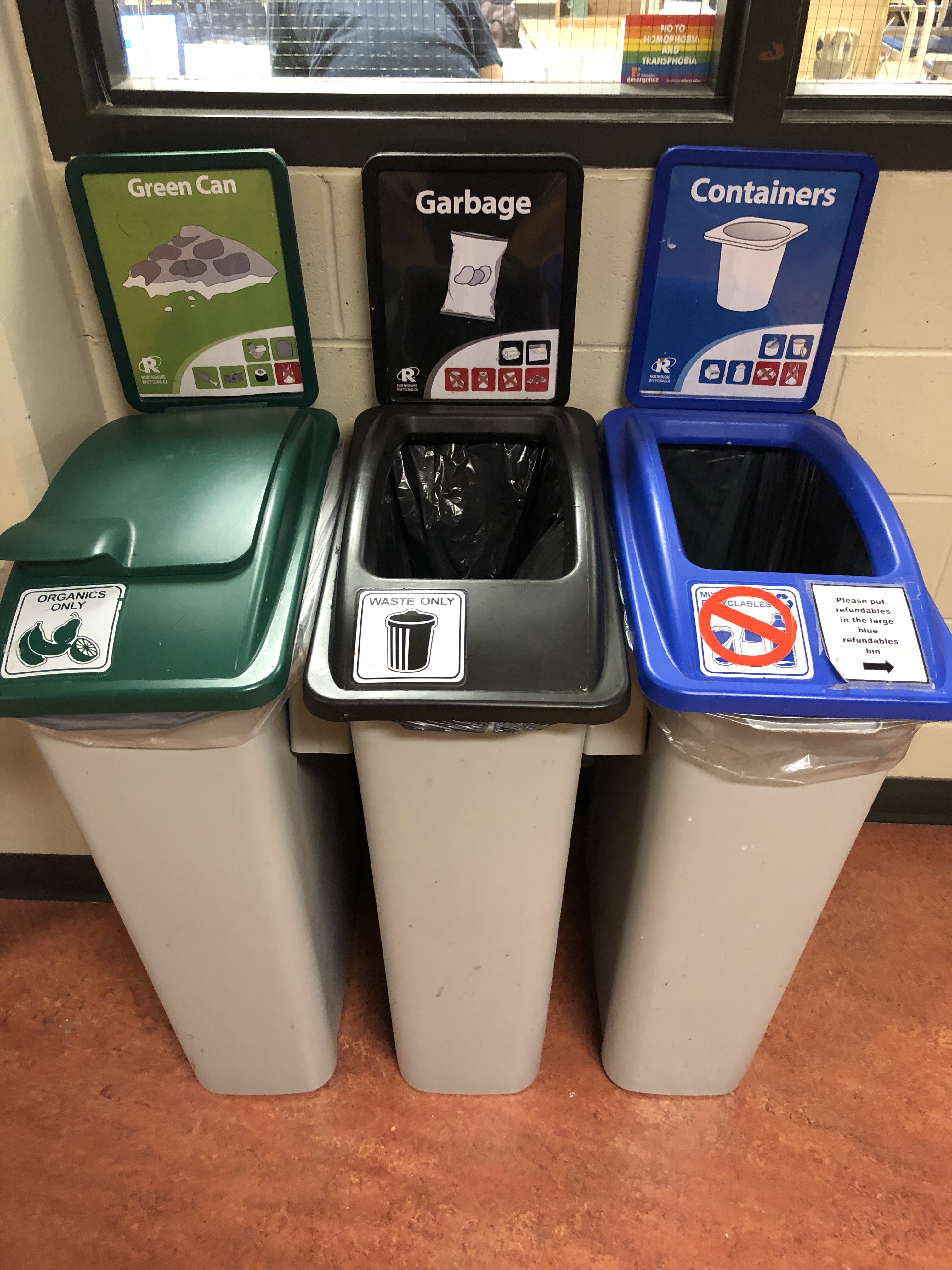
The second phase of the cycle is Ask Tons Of Questions. In this phase you have to come up with a lot of questions to help you understand the problem. These questions are important because they will allow you to come up with the best solution to the problem as possible. Some examples of questions we had are “what is the biggest problem with our schools recycling program?” And “why are there problems with the recycling?” We had a ton of questions we needed to answer to solve our problem. To answer these questions we had to go onto the third phase of the launch cycle.
The third phase of the launch cycle is Understand The Problem. This is the research phase. You now have to answer all of the questions you had before and probably more as you go along. You can do this with interviews, articles, data, videos, and more. This phase is very important because if you don’t understand your problem then you won’t be able to completely solve it. For our research Hannah and I went through the recycling bins. We realized that there was more garbage in the wrong bins than in the right bins. This is a huge problem because this means that everything would end up in the trash instead of the compost or recycling unless our janitors went through it every night. Hannah and I collected data from lots of the bins in our school and we did some more research about these types of issues online and we found that this is a very common problem. We then had to take all of this research and apply it to the next phase of the cycle.
The fourth phase of the launch cycle is to Navigate Ideas. This is the phase where you finally have to come up with a solution to your problem. Hannah and I started off with a brainstorm. We came up with tons of ideas of solutions to the problem. We then went through our ideas and weeded out the bad ones. We had a few good ideas and we wanted to try and combine them. Our first idea was to set up a volunteer program where students would watch the bins at break and lunch to make sure everything went in the right bin. We set up a meeting with our principal to see if this was a good idea. We realized this was unrealistic because no one would volunteer and it was too late in the year to implement it. Our principal liked our other idea a lot more. Our other idea was to change the signs on the bins to make it more clear what goes in each bin. This was a better idea that we could implement. After we had a solid plan for our idea we were able to move onto the next phase.
The fifth phase is to Create a Prototype. This is my favourite phase because we finally get make something and solve the problem. For this phase we got to make the new signs for the bins. We wanted to personalize them for our school so the students would know where the most commonly used grab age goes. We made the posters with pictures of things from our school such as bowls from our cafeteria and garbage from our vending machines. The other part of our project was to create a website. We wanted to make a website where students could go if they weren’t sure which bin to throw their stuff into. The website had extensive lists of what can and can’t go into each bin. In PLP nothing is ever perfect on the first try so we had to go into the next phase of the cycle.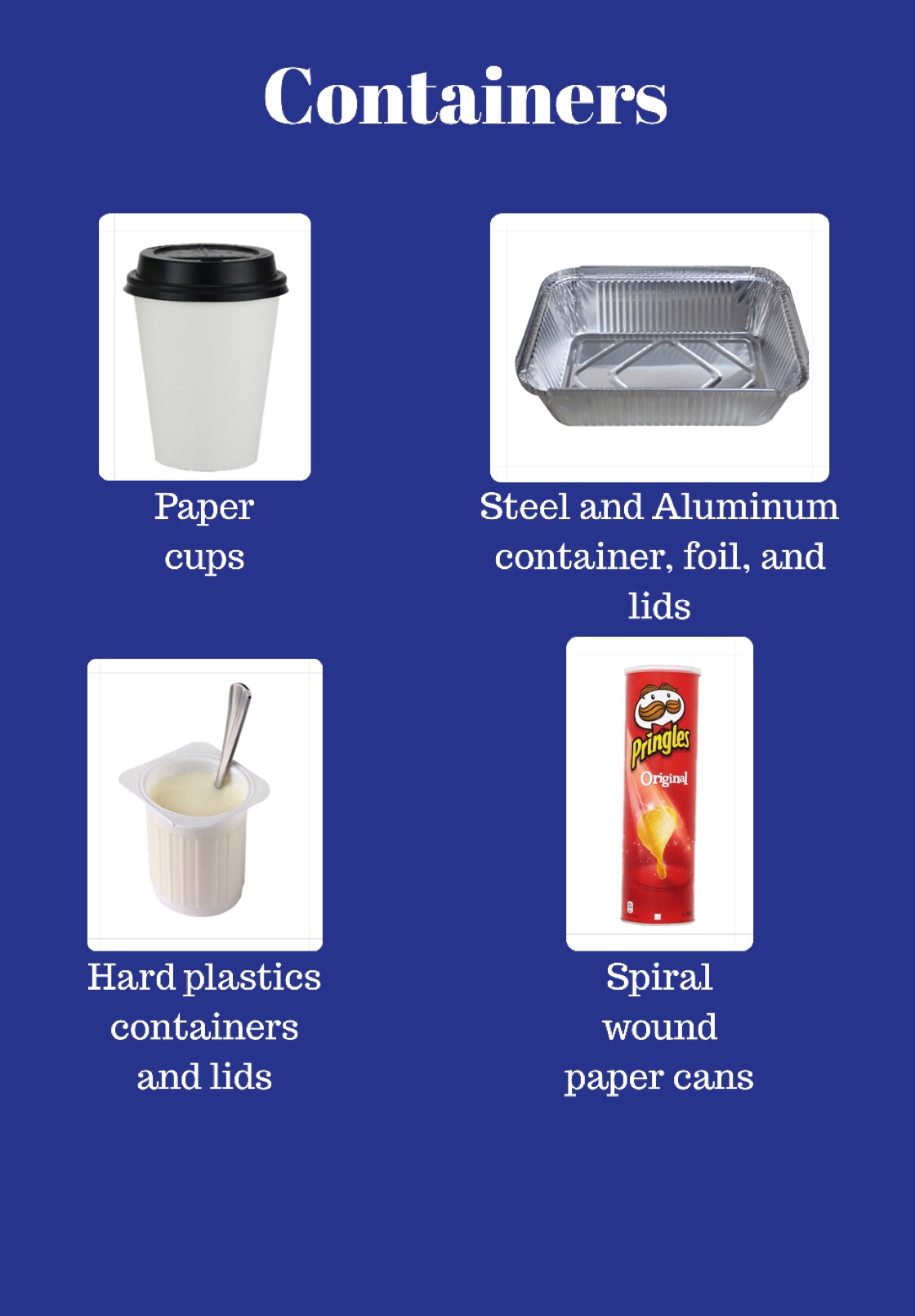
The sixth phase of the launch cycle is to Highlight and Fix. Here we had to get some feedback on our first prototype and then fix and critiques we got. We asked a few friends about our first posters and they said that they looked a little plain. We then asked about our website and they said to add a page about why we did this project and what exactly we did. We got a little bit more critique and they we made our second draft. Normally we are supposed to have three prototypes but we were very short on time this year so we were only able to do two. We wanted to see if our project had worked so we went around to the bins again and saw that the signs have helped. There was significantly less garbage in the wrong bins and this made me really happy. We also did a poll of the students and the majority of them said they noticed the signs and they helped them know where everything goes. Finally after lots of hard work we were ready for the final phase of the launch cycle.
Seycove Waste Management Website
The last phase of the cycle is to Launch to the World. In this phase you show your project to the world in any way you choose. In PLP we have the exhibition where we set up our work and show it to everyone. I’d say that roughly about 300 people came to see the projects. Hannah and I had our project set up and every time someone came by we had to explain our project to them. This is the best way to showcase our projects because we get to show them to people in our community. Many of our projects were based around our community so it’s good to let everyone here see them.
For the exhibition we don’t just set our projects up and show people them. We are each put into groups and have to decorate a room based on the group we are in. This year the group’s were based on the 17 goals for sustainable development. For my groups goal we wanted to design our room to look like a community that is very responsible with their consumption and production. For the exhibition we also got some grade 9’s and 8’s put into our groups. The grade 9’s and 8’s in my group were Lucas, Emily, Melika, Jamie, Alivia, and Jackson. We also had to pick out a food or drink to serve and a game that all went along with our theme. This took a lot of planning, preparation, and time to set up but it turned out amazing.
Blue Sky: Responsible Consumption and Production Planning
For decorations we set up plants all over the room. We used as much natural light as possible to save electricity. We had a picture of a forest projected on the screen and we had very calming music playing. We also made a few signs out of paper from the recycling bin to reduce the amount of waste we had. For our food we made cookies out of all organic ingredients and used as little packaging as possible. For a drink we had a lemon and cucumber water that we served in reusable mason jars. We also had paper straws for the water. Our game was that the person playing was given some garbage and they had to throw it in the right bin in as little time as possible and if they beat the record they got a gummy worm because bugs are a good part of a sustainable diet. We had lots of fun setting it up and I was so proud with how it turned out.
Hannah and my presentation went really well. I am normally extremely nervous for exhibitions because talking to people kinda scares me but I was really happy with my project so I wasn’t nervous at all. We made a poster board that showed the before and after of the waste bins and also what we did to change them. We had both of our iPads out on display. On Hannah’s iPad was the poll results and my iPad had the website on it. Everyone seemed to really like our project. Tons of people told us their stories of bad waste management. I ended up loving telling people about our project because they were all very happy that someone was doing something about this problem.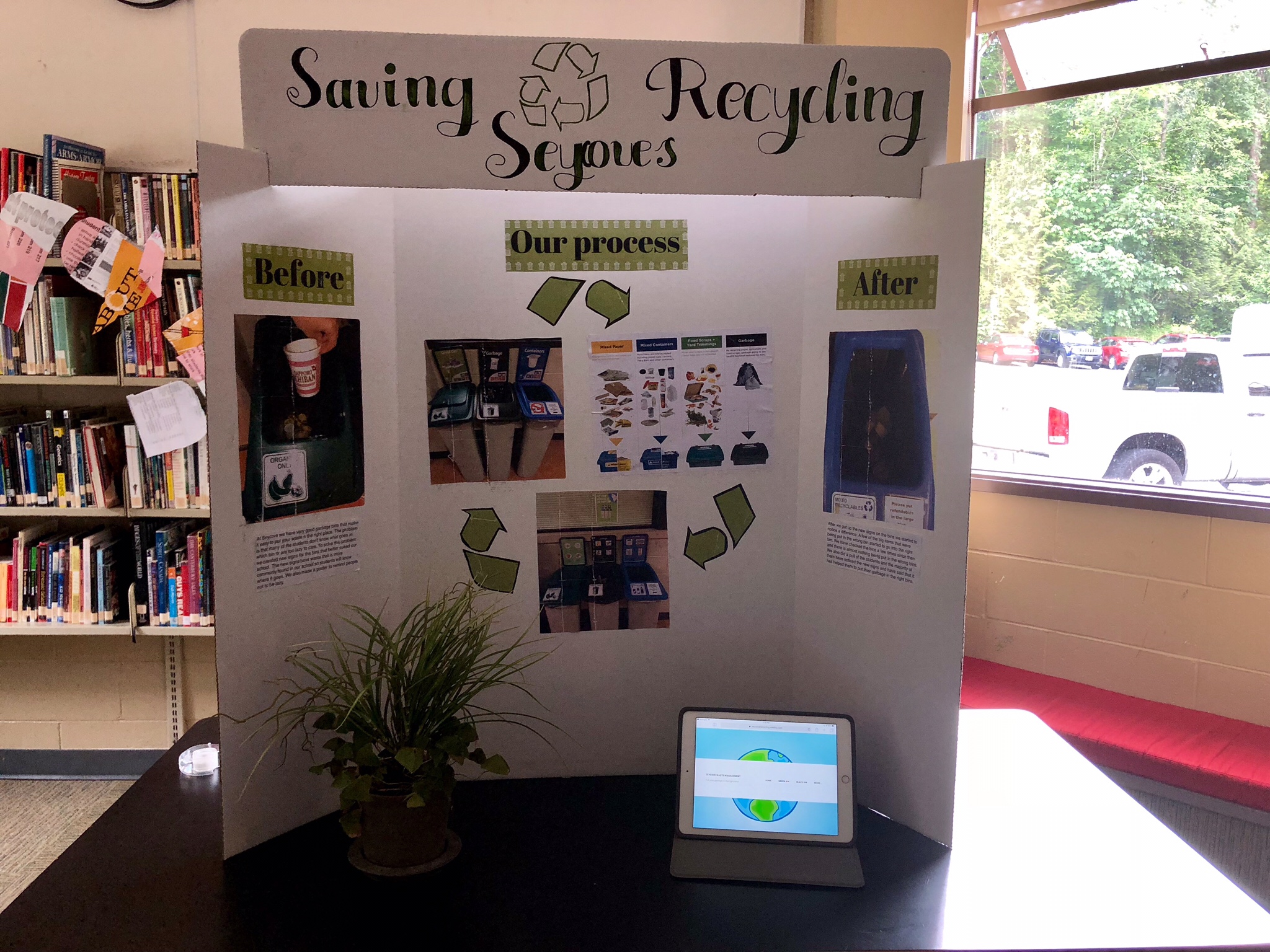
This years Blue Sky was a little more challenging than any other but I feel like it went well. I had lots of fun working with Hannah on this project even though it meant I had to go digging through the trash. I had a really good group for the exhibition and we all worked really well together to set the room up. Everything went even better than I expected and I loved Blue Sky this year. I’m not sure what we are doing next year but whatever it is I am excited for it.



